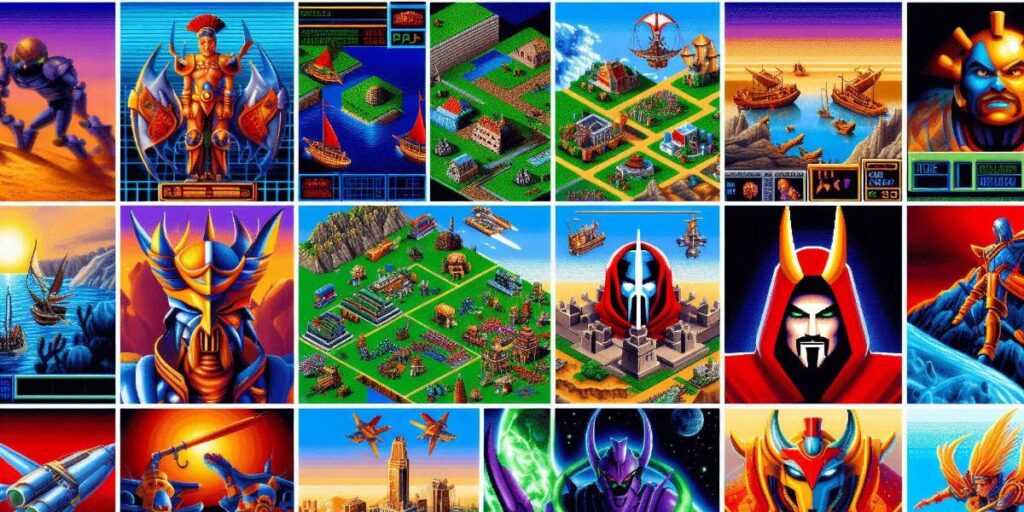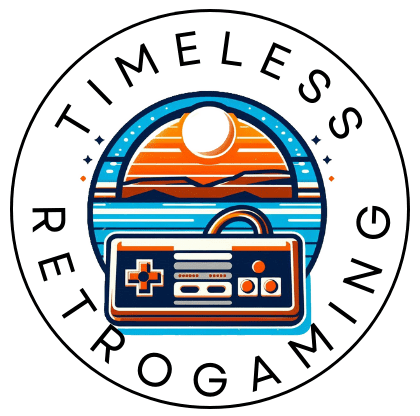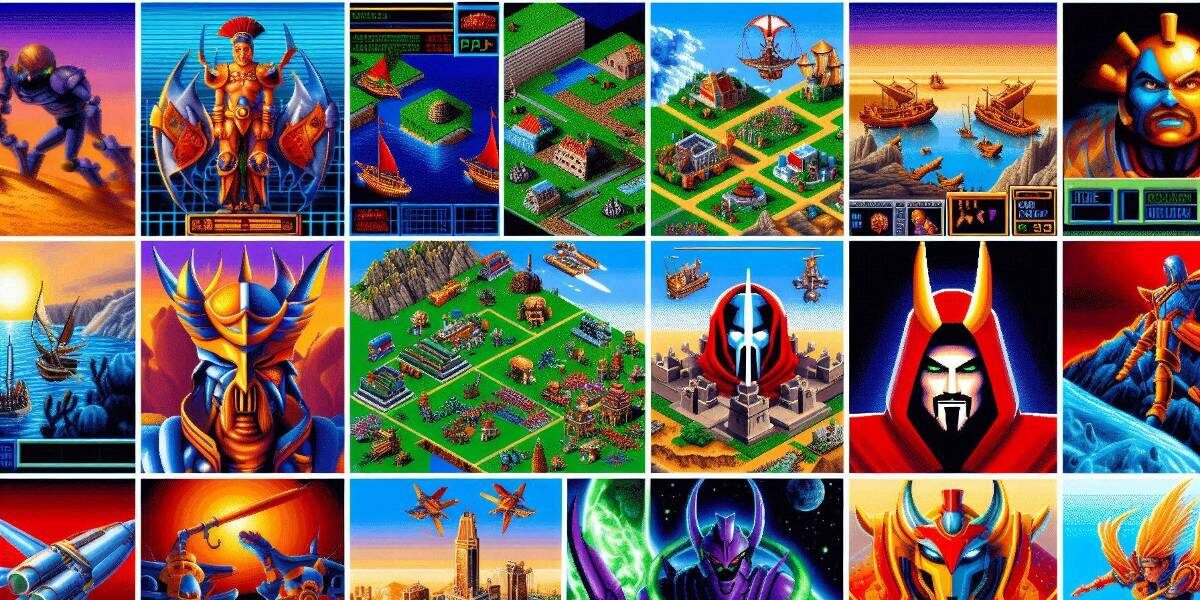
The 90s were a wild time for gamers. Forget your sleek graphics and complex gameplay mechanics from today—back then, things were a bit more raw and rugged. This was the golden age when strategy games found their footing. These games weren’t just about quick reflexes; they demanded brains, patience, and a knack for planning.
During this decade, strategy games skyrocketed in popularity, quickly becoming a favourite genre among gamers.
The appeal? The power to command armies, build civilizations, and outthink opponents. It was no longer about just jumping on platforms or shooting enemies; it was about outsmarting them.
You had giants like ‘Civilization‘ that let you shape the fate of nations, and ‘StarCraft,’ which became a phenomenon in both casual gaming circles and professional eSports. The cool part is that these games didn’t just entertain—they left a lasting impact on how games are developed today. They introduced mechanics and gameplay styles that we now see as standard in the genre.
But let’s not kid ourselves, a trip down this memory lane isn’t complete without a shout-out to some legendary titles that defined that era. Whether it was turn-based marvels that required you to think several moves ahead or real-time strategy classics where every second counted, the 90s offered a little something for every type of strategist.
Join me as we explore some of the best strategy games from the 90s. Let’s remember what made these games legendary and why they’re still worth talking about today.
Top 5 Turn-Based Strategy Games of the 90s
Turn-based strategy games were essential for anyone looking to flex their strategic muscles. These games didn’t rush you; they made you think, plan, and calculate every move. Let’s check out some gems from the 90s that ruled the turn-based category.
‘Civilization II‘ stands out as a milestone in gaming history. This game lets you build an empire from the ground up, managing everything from technological advancements to diplomatic relations. It wasn’t just a game; it was a course in world domination. Even today, it can teach you valuable lessons about resource management and long-term planning.
‘Heroes of Might and Magic III‘ was a dazzling blend of fantasy and strategy. You’d spend hours navigating through magical landscapes, capturing towns, and battling mythical creatures. It’s colourful graphics and intricate gameplay sucked you right in. It’s a game where your decisions truly matter, from army composition to spell choices.
‘X-COM: UFO Defense‘ spiced things up by adding an element of suspense and fear. Dealing with alien invasions wasn’t just about muscle; it was also about tactical genius. You had to manage resources, research alien technology, and make sure your team survived turn after turn. The game was a masterclass in tension and planning.
Then there’s ‘Master of Orion II’. It took the strategy genre to space, allowing you to explore and conquer the galaxy. Balancing diplomacy, war, and technological advancements, the game was a comprehensive strategy package, making you think beyond the battlefield.
And of course, ‘Final Fantasy Tactics‘. This gem took a beloved RPG franchise and combined it with complex grid-based combat. Between the deep story and intricate job system, you were always on your toes. It made you feel like every decision counted, from positioning soldiers to choosing abilities.
Each of these turn-based strategy games didn’t just test your patience; they rewarded thorough planning and smart decision-making. Whether you were building empires or saving the universe, they offered a unique challenge that still resonates with players today.
Top 5 Real-Time Strategy Games of the 90s
Real-time strategy (RTS) games were the ultimate test of quick thinking and multitasking. Unlike their turn-based cousins, these games demanded split-second decisions and rapid-fire strategies. Let’s go through some of the absolute classics that defined the RTS genre in the 90s.
First up, ‘StarCraft‘—an absolute powerhouse that took the genre to new heights. With its balanced factions and gripping storyline, it wasn’t just a game; it was a phenomenon. Whether you picked the Terrans, Zerg, or Protoss, you had to master unique strategies and adapt to ever-changing battle conditions. ‘StarCraft‘ didn’t just entertain; it defined competitive gaming for years to come.
‘Warcraft II: Tides of Darkness‘ was another titan in the RTS world. Its focus on resource management and epic battles was unmatched. This was the game that set the stage for the ‘Warcraft‘ franchise, which would eventually give birth to the massively popular ‘World of Warcraft‘. From building fortresses to commanding legions, it was all about outsmarting and outmanoeuvring your opponents.
When ‘Age of Empires‘ hit the scene, it added a historical twist to the RTS genre. The game allowed players to guide their civilization through different ages, from the Stone Age to the Iron Age. Managing resources, developing technologies, and leading battles, was like taking a history lesson while preparing to conquer your foes. A versatile and rewarding experience for any strategy enthusiast.
‘Command & Conquer‘ brought modern warfare into the mix. With its military-themed combat and engaging storyline, it offered a grittier environment compared to other fantasy and sci-fi settings. The introduction of full-motion video cutscenes added a level of immersion that was groundbreaking for its time. This game laid the groundwork for many modern RTS games and still holds up as a classic.
‘Total Annihilation‘ pushed technical boundaries with its 3D terrain and physics-based combat. Unlike most RTS games of the time, it allowed for unprecedented control and strategy, making every single decision impactful. Whether you were constructing intricate bases or leading vast armies, it provided a rich, tactical experience that was ahead of its time.
These real-time strategy classics didn’t just test your reflexes; they pulled you into richly crafted worlds. The challenges they posed were relentless, but the rewards were immense. They laid the foundation for many of the mechanics and gameplay elements we see in today’s strategy games.
Underrated Gems: Lesser-Known Strategy Games Worth Playing
Not every great strategy game from the 90s got the spotlight it deserved. Some hidden gems flew under the radar, offering richly complex and intriguing experiences that captivated those fortunate enough to find them. If you’re craving something different, these lesser-known titles are worth a look.
‘Imperialism‘ was a fascinating game that lets you control a nation on the brink of the industrial revolution. Balancing resources, diplomacy, and warfare, challenged your strategic mind in every conceivable way. The deeper mechanics of trade and colonization added layers of complexity that kept you hooked.
‘Warlords III: Darklords Rising‘ mixed high fantasy with deep strategy elements. Commanding armies, capturing cities, and completing quests felt incredibly satisfying. It delivered epic battles and strategic depth, proving that even less-celebrated titles could offer a rich gaming experience.
‘Myth: The Fallen Lords‘ stood out with its impressive tactics-based combat. Unlike most games focused on base-building, this one prioritized battlefield strategy. Every unit mattered, and every decision could lead to victory or crushing defeat. Its narrative-driven campaigns added an extra layer of engagement, keeping players glued to the screen.
Then there’s ‘Lords of the Realm II‘, which blended turn-based strategy with real-time battles. Managing your medieval kingdom, from harvesting crops to waging wars, felt like running a mini-empire. The intricate layers of resource management and diplomacy ensured there was never a dull moment.
‘Dark Reign: The Future of War‘ brought sci-fi elements into the mix, offering a richly detailed world and complex scenarios. The game’s AI was ahead of its time, providing challenging opponents that kept players on their toes. It introduced features like customizable units and real-time adaptation to strategies that offered immense replay value.
Each of these underrated gems may not have achieved blockbuster status, but they delivered compelling, intricate gameplay experiences that truly stood out. If you’re on the hunt for something off the beaten path, these titles shouldn’t be missed.
Legacy and Influence of 90s Strategy Games
The impact of 90s strategy games extends far beyond just nostalgia. These games laid down the foundational mechanics and principles that still influence the genre today. Their legacy can be seen in countless ways, from the mechanics of modern games to the thriving fan communities that continue to celebrate them.
One massive influence is on modern game development. Many game designers today cut their teeth on 90s strategy games, drawing inspiration from their intricate gameplay systems. The complexity and depth of these older games serve as a benchmark for what strategy games can achieve. Titles like ‘Civilization‘ and ‘StarCraft‘ have inspired countless spiritual successors and direct sequels, keeping the spirit of 90s strategy alive and kicking.
The modding communities around these old games are another testament to their lasting appeal. Even decades later, dedicated fans are still creating new content, patches, and expansions. Sites teeming with user-generated content keep these games fresh and relevant, proving their timeless appeal.
The competitive scenes for games like ‘StarCraft‘ or ‘Warcraft II‘ also highlight the lasting influence of 90s strategy games. These games were pivotal in the early days of esports, setting the stage for the massive online tournaments we see today. The strategies and skills honed in these classic games still resonate in current competitive gaming circles.
Interviews and quotes from industry experts often reveal a deep respect for these pioneering titles. Game developers frequently mention how the innovations and gameplay mechanics from the 90s influence their designs today. They serve as constant reminders of a time when creativity and complexity ruled the gaming landscape.
The enduring appeal of these games is more than just fond memories—it’s about the solid foundation they built for the strategy genre. They showed us that games could be more than mindless entertainment; they could be intricate, challenging, and deeply rewarding. It’s no wonder that even today, gamers and developers alike hold these titles in such high regard.

